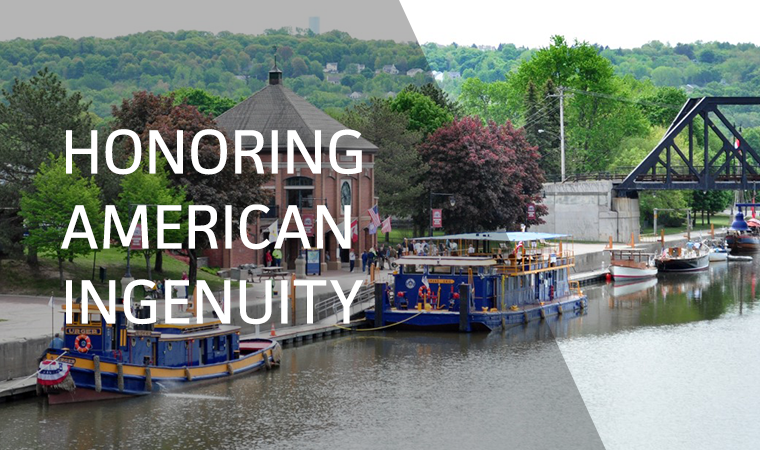 Supporting New York Power Authority and NYS Canal Corporation
Supporting New York Power Authority and NYS Canal Corporation
This year, America celebrates a bicentennial known perhaps only to a relative few in this country. That is likely to change soon and for the good since this occasion marks an achievement representing genuinely American qualities of courage, innovation and perseverance. If properly considered and understood, this moment in history could serve as a unifying experience occurring at a time when all too much and too many in our society work to divide Americans from one another. We suffer a terrible loss if we miss this unique chance to take common pride in what makes us great.
In 1817, construction began on the Erie Canal. It was an idea fraught with risk, denounced with derision, and labeled “ … little short of madness” by no less than Thomas Jefferson. Why all the opposition? To work, the canal would have to traverse 363 miles of then dense wilderness. It would require a system of locks capable of raising boats 568 feet from the Hudson River to Lake Erie. It would employ engineering and construction techniques and equipment that literally did not exist when the first spade of earth was turned at Rome, New York on July 4th of that year. An argument can be made that engineering in America had to be invented even as this monumental infrastructure project was being accomplished.
That such obstacles were overcome is cause alone for recognition. The uniquely American aspects of the project go beyond engineering and warrant real celebration.
Begin with a kind of resolute certainty in a singular idea. That idea—for a canal to move goods and people between the expanding east to the western frontier—had been discussed for some time with little progress. A man in prison proved the genius behind the project’s adoption. Jesse Hawley, a flour merchant who ended up in debtor’s prison, wrote extensively and convincingly about the potential for the canal. Hawley’s experience of failure and financial ruin resulting from his inability to ship grain economically from upstate New York compelled his determination. Neither an engineer nor surveyor, Hawley used his time in prison to do the analytical work on which the final concept was based.
Courage pervades the history of the Erie Canal and political courage especially. DeWitt Clinton championed the canal in his role as a member of the Erie Canal Commission. He brought the idea to successive Presidents and the U.S. Congress only to be turned down repeatedly for federal funding. Resilient and determined, he became the driving force behind securing approval by the New York legislature for the $7 million needed to fund the project.
The canal itself was one thing. The methods and implements of its realization were another thing entirely. The men given the challenge of designing and building the canal were rank amateurs. None had done anything remotely like this. None were deterred by this. One paid his own way to Europe to study canals there and bring back knowledge and expertise that didn’t exist here. Others knew just enough about surveying with a compass to believe they were capable of planning the route and supervising construction. Thousands of people, most of them immigrants, signed on for the excruciating labor of digging what was called “Clinton’s Ditch” quite literally by hand.
It took eight years to complete, but almost immediately, the benefits were realized. Goods were transported at a fraction of the prior cost and significantly faster than ever before. Frontier towns along the canal boomed and became economic engines of national growth. Even tourism as an industry came into being as citizens rode canal boats for leisure and pleasure.
Today, the Erie Canal continues to operate as a pathway for commercial and recreational transport contributing substantially to the economy of New York and the nation.
The especially American principle that drove the canal project is a belief that here, anything is possible. This national confidence arises from our shared sense of determination, capacity for innovation, and recognition of the value of hard work. The Bicentennial of the Erie Canal, which begins in Waterford, New York on May 19, is as much a celebration of the American spirit as it is of an engineering marvel.
Stanton Communications has been selected by the New York Power Authority and the New York State Canal Corporation to assist with staging Bicentennial events all summer long. We are immensely proud of our association with this project because we believe the inherent special qualities of those who fostered the canal’s creation and who operate it today are reflective of our firm and the professionals who come to work here every day saying, “Let’s do this!”
Please visit NYcanals200.com for more information about the canal and the Bicentennial Celebration. More than that, please consider how to become part of this important and once-in-a-lifetime celebration, even if in no other way than to reconnect with our uniquely American values and belief in our incandescent possibilities as a people and a nation.